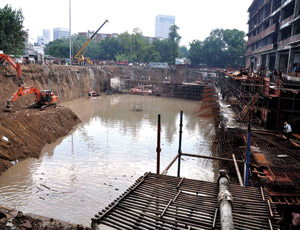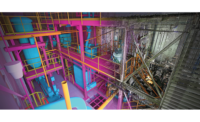With little time remaining before the Oct. 4 start of the 2010 Commonwealth Games in Delhi, India, the sporting event’s already-escalated $1.6-billion construction project is straining to reach the finish line. Teams from more than 60 U.K.-linked nations are set to arrive next month to test out venues, occupy new sports villages and use upgraded infrastructure. But stadium roofs are leaking, and work on most of the 17 new and rehabbed arenas and other projects is months behind schedule and has questionable procurement arrangements, officials say.


With the overall price tag of the games now estimated at $2.3 billion, the cost is “a matter of serious economic irregularity,” says Vijay Goel, leader of India’s opposition Bharatiya Janata Party. “It is a tragedy that in the name of speedy construction, many procedural requirements have been blatantly violated in tenders and bidding.” The sporting event is the largest ever to be held in India, with thousands of athletes and up to 100,000 more spectators expected.
The original venue completion date—last January—has shifted again, the fifth delay this year. In published reports, Delhi Chief Minister Sheila Dikshit says the venues won’t be ready for public use until mid-September, citing impacts from unusually heavy monsoon rains.
The 75,000-seat Jawaharlal Nehru Stadium, which will host the opening and closing ceremonies, remains unlandscaped. A stadium annex that will host weight-lifting events has been leaking, embarrassing the government when it inaugurated the facility in early August.
The existing facility’s new 53,800-sq-meter Teflon-coated roof was designed by Berlin-based architecture firm von Gerkan Marg & Partner in conjunction with structural engineering firm Schlaich Bergermann & Partner, Stuttgart. Spanning 240 m, the roof is the largest cable-supported structure of its type in Asia, according to Birdair Inc., Amherst, N.Y., which is responsible for the glass-fiber covering.
Government contractors complain about the lack of coordination among the nine agencies charged with supervising project completion.
Sports Minister M.S. Gill acknowledges the difficulties experienced by government agencies in managing the workload, particularly on some of the more uniquely designed facilities, but he says the construction problems would be addressed.
However, project engineers have a different story to tell.
“Unlike Western countries, in India, we have uneducated and unskilled labor,” says one site engineer, asking not to be named. “A dome roof becomes complex because of the curvature, and water seeps through gaps. This is extremely difficult to control.” He adds that the roof shape does not permit fast drainage.
“Corners were cut as skilled labor is expensive,” the engineer contends. “[Officials] needed to use epoxy but have used bitumen instead. It is difficult to overlap and make [the roof] watertight. This is bound to create problems for years to come. India should have gone in for simpler roofs.”
India’s Meteorological Dept. predicts more rain to come in September. “Contractors factor in lesser productivity, keeping the rains in mind,” says another project engineer. “The waterlogging at the stadiums would not have occurred if they had readied the stadiums on time.”
The last venue to be completed is the Mukherjee Swimming Stadium, delayed by eight months because of problems in demolishing its original structure, officials say. The facility covers an Olympic-size pool with an elliptical stressed cable roof that is 160 m at its widest point. Paris-based Freyssinet S.A. supplied and installed the cable.
Infrastructure and venue work managed by Delhi officials has been mired in delays and accusations of corruption and mismanagement, the national government claims in a new report. Its Central Vigilance Commission contends that almost all the projects exceeded their construction bid prices, were delayed and included poor-quality work.
The commission’s report claims electrical installations were not tested in 14 of 17 venues before they were turned over for public use. “Any type of electrical [mishaps] cannot be ruled out,” says the document.
Concrete core samples taken from already-laid concrete also failed to meet strength requirements during testing. “This indicates forging of testing records,” says the commission. The commission also notes evidence of inappropriate concrete mix designs and defects in anticorrosion treatment of rebar.
Vidur Bhardwaj, director of Delhi-based architect 3C Co., compares the project’s progress to that of the 2012 London Olympics’. “In the U.K., with the Games two years away, they have started installing [stadium] seats,” he says. “The work [here] didn’t start early enough.It’s more than teething troubles.” Problems are exacerbated because “the government tries to do everything itself,” he says. “It should have left it to private companies.”


Post a comment to this article
Report Abusive Comment